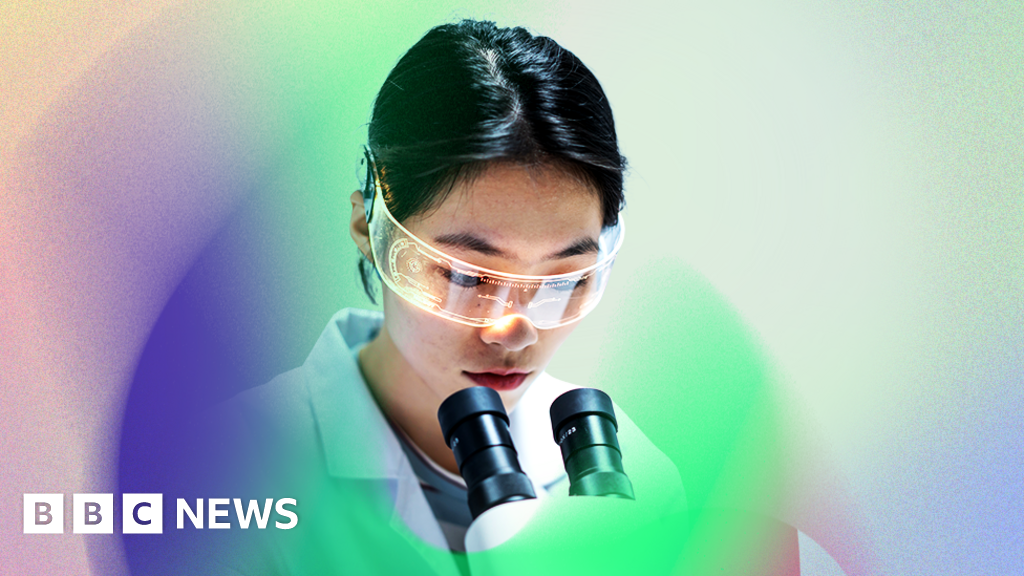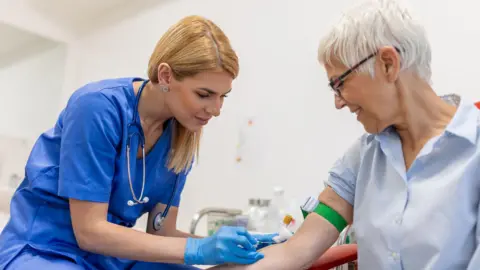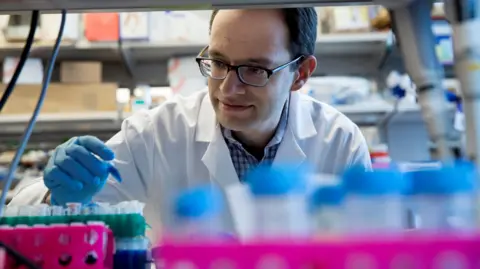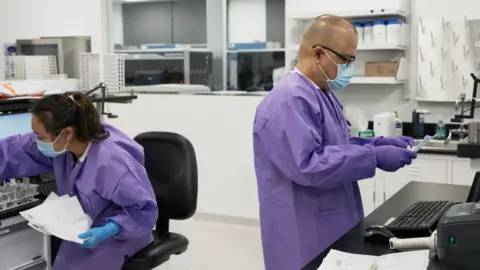
 Getty Photos
Getty PhotosThat is the third characteristic in a six-part collection that’s how AI is altering medical analysis and coverings.
Ovarian most cancers is “uncommon, underfunded, and lethal”, says Audra Moran, head of the Ovarian Most cancers Analysis Alliance (Ocra), a world charity primarily based in New York.
Like all cancers, the sooner it’s detected the higher.
Most ovarian most cancers begins within the fallopian tubes, so by the point it will get to the ovaries, it might have already unfold elsewhere too.
“5 years previous to ever having a symptom is if you might need to detect ovarian most cancers, to have an effect on mortality,” says Ms Moran.
However new blood exams are rising that use the facility of synthetic intelligence (AI) to identify indicators of the most cancers in its very early levels.
And it isn’t simply most cancers, AI may pace up different blood exams for doubtlessly lethal infections like pneumonia.
 Memorial Sloan Kettering Most cancers Heart
Memorial Sloan Kettering Most cancers HeartDr Daniel Heller is a biomedical engineer at Memorial Sloan Kettering Most cancers Heart in New York.
His group have been developed a testing know-how which makes use of nanotubes – tiny tubes of carbon that are round 50,000 instances smaller than the diameter of a human hair.
About 20 years in the past, scientists started discovering nanotubes that may emit fluorescent mild.
Prior to now decade, researchers discovered learn how to change these nanotubes’ properties in order that they reply to nearly something within the blood.
Now it’s potential to place thousands and thousands of nanotubes right into a blood pattern and have them emit totally different wavelengths of sunshine primarily based on what sticks to them.
However that also left the query of deciphering the sign, which Dr Heller likens to discovering a match for a fingerprint.
On this case the fingerprint is a sample of molecules binding to sensors, with totally different sensitivities and binding strengths.
However the patterns are too delicate for a human to select.
“We are able to have a look at the information and we is not going to make sense of it in any respect,” he says. “We are able to solely see the patterns which are totally different with AI.”
Decoding the nanotube knowledge meant loading the information right into a machine-learning algorithm, and telling the algorithm which samples got here from sufferers with ovarian most cancers, and which from individuals with out it.
These included blood from individuals with different types of most cancers, or different gynaecological illness that could be confused with ovarian most cancers.

An enormous problem in utilizing AI to develop blood exams for ovarian most cancers analysis is that it’s comparatively uncommon, which limits the information for coaching algorithms.
And far of even that knowledge is siloed in hospitals that handled them, with minimal knowledge sharing for researchers.
Dr Heller describes coaching the algorithm on accessible knowledge from only a few 100 sufferers as a “Hail Mary move”.
However he says the AI was capable of get higher accuracy than the most effective most cancers biomarkers which are accessible as we speak – and that was simply the primary strive.
The system is present process additional research to see if it may be improved utilizing bigger units of sensors, and samples from many extra sufferers. Extra knowledge can enhance the algorithm, simply as algorithms for self-driving automobiles can enhance with extra testing on the road.
Dr Heller has excessive hopes for the tech.
“What we might love to do is triage all gynaecological illness – so when somebody is available in with a grievance, can we give medical doctors a software that rapidly tells them it is extra prone to be a most cancers or not, or this most cancers than that.”
Dr Heller says this can be “three to 5 years” away.
 Karius
KariusIt isn’t simply early detection that AI is doubtlessly helpful for, it is usually rushing up different blood exams.
For a most cancers affected person, catching pneumonia may be lethal and, as there are round 600 totally different organisms that may trigger pneumonia, medical doctors must conduct a number of exams to determine the an infection.
However new kinds of blood exams are simplifying and rushing up the method.
Karuis, primarily based in California makes use of synthetic intelligence (AI) to assist determine the exact pneumonia pathogen in 24 hours, and choose the proper antibiotic for it.
“Earlier than our check, a affected person with pneumonia would have 15 to twenty totally different exams to determine their an infection in simply of their first week in hospital – that is about $20,000 in testing,” says Karius chief govt Alec Ford.
Karius has a database of microbial DNA which has tens of billions of knowledge factors. Take a look at samples from sufferers may be in comparison with that database to determine the precise pathogen.
Mr Ford says that will have been not possible with out AI.
One problem is that researchers don’t essentially at the moment perceive all of the connections that an AI would possibly make between the check biomarkers and the ailments.
During the last two years Dr Slavé Petrovski has developed an AI platform referred to as Milton that, utilizing biomarkers within the UK biobank knowledge to determine 120 ailments with successful fee of over 90%.
Discovering patterns in such a mass of knowledge is barely one thing that AI can do.
“These are sometimes complicated patterns, the place there might not be one biomarker, however you must consider the entire sample,” says Dr Petrovski, whose is a researcher at prescription drugs big AstraZeneca.
Dr Heller makes use of an analogous sample matching approach in his work on ovarian most cancers.
“We all know that the sensor binds and responds to proteins and small molecules within the blood, however we do not know which of the proteins or molecules are particular to most cancers,” he says.
Extra broadly knowledge, or the dearth of it, remains to be a disadvantage.
“Folks aren’t sharing their knowledge, or there’s not a mechanism to do it,” says Ms Moran.
Ocra is funding a large-scale affected person registry, with digital medical information of sufferers who’ve allowed researchers to coach algorithms on their knowledge.
“It is early days – we’re nonetheless within the wild west of AI now,” says Ms Moran.

